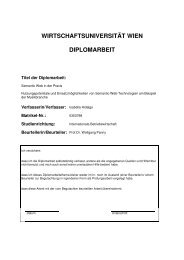Wirtschaftsuniversität Wien Magisterarbeit - SemanticLab
Wirtschaftsuniversität Wien Magisterarbeit - SemanticLab
Wirtschaftsuniversität Wien Magisterarbeit - SemanticLab
You also want an ePaper? Increase the reach of your titles
YUMPU automatically turns print PDFs into web optimized ePapers that Google loves.
Internet and areas of common Internet applications which use (sensitive) personal data<br />
will be introduced.<br />
2.2. General privacy on the Internet<br />
This section will deal with general privacy issues on the Internet. For that reason a<br />
common approach to categorize personal data as described in [Sar03] will be used. The<br />
three main categories are financial, medical and political privacy. Although all categories<br />
are generic, they are restricted to the World Wide Web and should introduce these issues<br />
based on examples. Therefore, financial privacy will be discussed on the examples of<br />
fraud and identity theft, medical privacy by discussing the transfer of patient records<br />
over the Internet and seeking medical help online and political privacy will be discussed<br />
by highlighting privacy issues in e-government and free speech on the Internet.<br />
2.2.1. Financial privacy<br />
When it comes to financial privacy, two threats are very common on the Internet: fraud<br />
(such as in online banking and phishing 1 ) and identity theft. According to [Sin07] a huge<br />
rise in online banking fraud could be identified in the last years which mainly is due to<br />
two reasons: first of all, Internet access has become very cheap in most industrialized<br />
countries and banks try to get their customers to use online banking for obvious reasons:<br />
for clients, it is a very convenient way to conduct banking business. For banks, it is a way<br />
to cut costs on a double-digit scale [Tan00]. That means that there are a lot of online<br />
banking accounts which can be attacked. The second reason is the growing number of<br />
phishing mails because there are more and more users with e-mail addresses available.<br />
In most cases, these e-mails look like official e-mails, for example from the customers’<br />
bank, asking them to update their contact details. By including a link which leads to a<br />
fake website (very often a copy of the original website) it is made sure that users send<br />
their sensitive data to the “right” party. In the best case this data (such as address-data)<br />
is sold, more often account data is requested and used to debit money from a banking<br />
account. However, nowadays banks are aware of this problem and try to inform their<br />
customers as much as possible about such phishing mails. Additionally, new security<br />
features are being introduced to make phishing harder and therewith protect customer<br />
data [Hil06].<br />
Identity theft is closely connected to online fraud whereas [Kah08] defines it as “the<br />
malicious use of personal identifying data” and provides several types of identity theft:<br />
new account fraud, existing account fraud and friendly fraud. According to [Kah08] new<br />
account fraud is characterized by the use of personal data such as the social insurance<br />
number, date of birth and address to open a new account. By existing account fraud<br />
the theft of credit cards or other transactional account data is described whereas the<br />
1 “Phishing” describes a methodology to acquire sensitive information such as credit card numbers by<br />
sending users fake e-mails with links to fake websites which try to bring users to enter their sensitive<br />
data<br />
7





